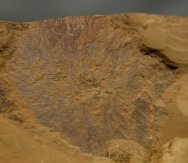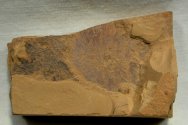Hazelia sp.
(Walcott, 1920)
Phylum Porifera, Class Demospongiae (or Demospongia), Order Monaxonida, Family Hazeliidae
Geological Time: Early Cambrian (~525 million years ago)
Size: 25 mm across
Fossil Site: Chengjiang Maotianshan Shale, Quiongzhusi Section, Yu’anshan Member, Heilinpu Formation Kunming, Anning, Yunnan Province, China
|
The Chengjiang Biota is one such fossil lagerstatte, with sponges having the second highest representations among metazoans, right after the arthropods. The Chengjiang sponges are though to have been suspension feeders that used tiering much like crinoids to feed at different heights in shelves and reefs within the water column. Sponges are, of course, primitive sessile animals that lack nervous, digestive and circulatory systems; despite their simplicity, or maybe because of it, they were among the very first animals and remain a robust phylum in modern times. Molecular clocks based on DNA or amino acid sequences support the appearance of sponges well prior to the Cambrian Explosion. Sponges fossils are known from the 580 million year old Ediacaran Period Doushantuo Formation, many of which have been placed in Family Demospongiae. However, the silica spicules often used to characterize demosponges do not appear in the fossil record until the Cambrian. The oldest undisputed sponge fossil date to the Neoproterozoic (~ 700 mya), and molecular biomarkers suggest an appearance as early as 1800 mya at the end of the Paleoproterozoic. Some sponge internal skeletons comprise soft spongin protein that poorly fossilizes, but many have exoskeletons composed of interwoven spicules made of calcium carbonate or silicon dioxide that do preserve well and add beauty to their fossil remains. The latest evolutionary biology research suggests that the closest sponge relatives are choanoflagellates, single-celled organisms very close to sponge choanocytes. If so, the Metazoa evolved from animals quite similar to sponges, further suggesting that sponges could be paraphyletic (i.e., sponge ancestors may have given rise to all non-sponge Metazoa as well as extant sponges). Also see: Chengjiang Biota, Chengjiang Fossils, Cambrian Explosion
|

